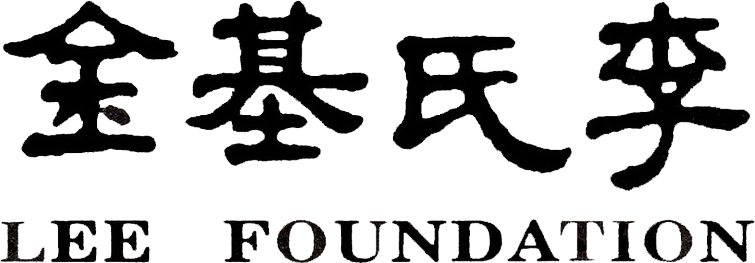We are delighted to share details from our digital performances this August.
Pibare Rama Rasam – thoughtful dance initiative dedicated to lord Rama curated by N. Srikanth Natarajan & Aswathy Nair. In this series of performances that was live streamed through Rasanubhava Official YouTube channel, 31 male dancers from different parts of the world came together to perform for 31 days of the month of Aadi(katkadaka Maatham). In Kerala it is known as Ramayana Maatham where devotees practice chanting of Ramayana through out the month for the well being of every one.
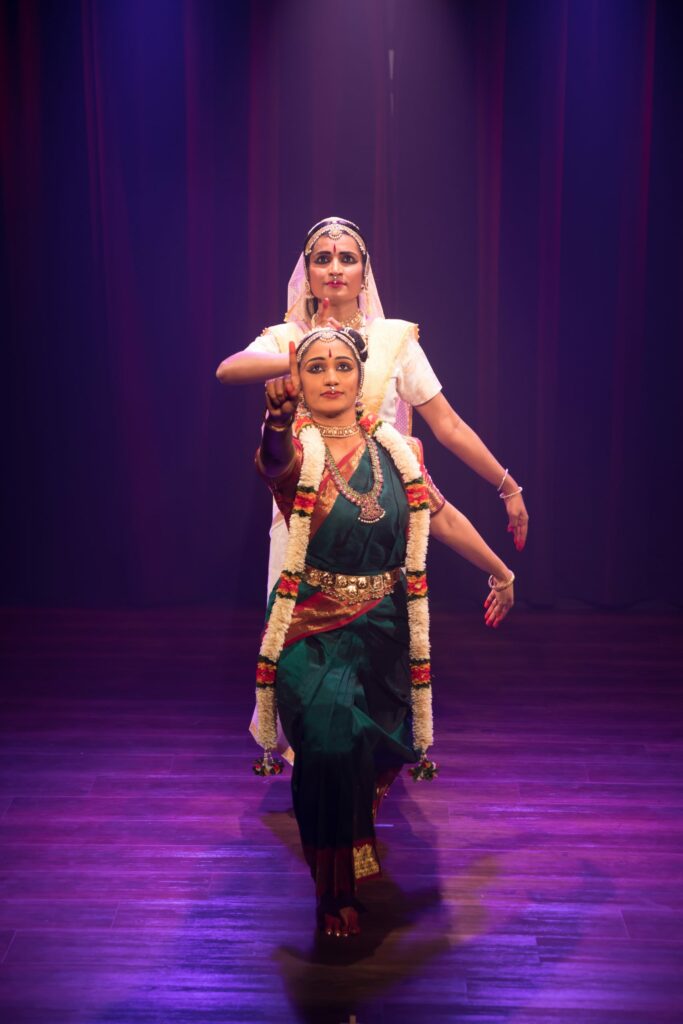
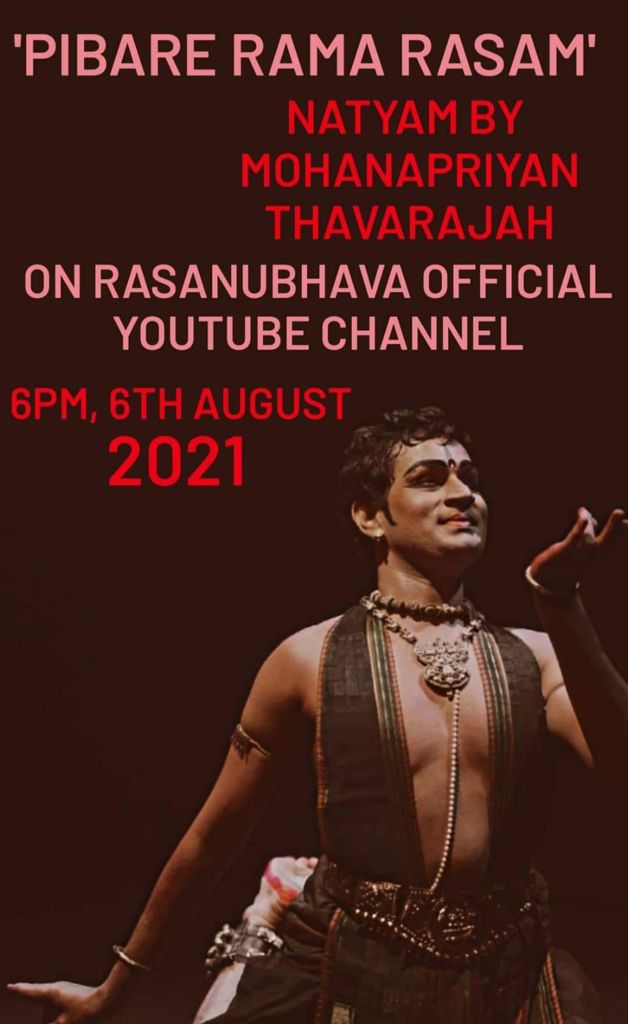
On august 6th, Mohanapriyan Thavarajah, Resident choreographer and principal dancer presented the immortal lullaby “Mannupugazh” composed by a prince of the Chera dynasty who became a saint-poet called Kulashekara Azhwar. He was one of the twelve saints of the Bhakti cult of Vaishnavism called Azhwars. This lullaby is addressed to Lord Rama who is also known as Lord Sowriraja Perumal in the temple of Thirukannapuram. The lyrics denote the experience of the poet seeing Lord Rama as a child and singing the melodious lullaby to put him to sleep. Through this Lullaby, Mohanapriyan dances the glory of Lord Rama and seeks peace and harmony in the silence of Lord Rama’s sleep. Gratitude to the creative team who transformed this experience from Vision – Music – Dance – aesthetics – Video. Click here to enjoy the humble offering:
- Artistic Direction – Aravinth Kumarasamy
- Choreography – Mohanapriyan Thavarajah
- Vocal and Music Arrangement – Karthik Raveendran
- Percussion – Praveen Sparsh
- Lights – Alberta Wileo
- Venue – Avai Apsaras Arts Dance Company
- Videography- Lijesh Karunakaran
Ananya Samarpana Festival is held from 13 Aug – 12 Sep 2021 hosted by Shruti Laya Dance School where Apsaras Arts was featured on the premiere paid online showcase on 15th Aug 2021. Our senior company dancers Deva Priya Appan and Seema Hari Kumar presented an adaptation from their thematic performance – Dvayam: Perspectives of Duality. Where there is two, there arise conflict, union, discord and harmony. The concept of duality is age old for where there is light there is darkness, where there is man there is woman. In a 40-min segment, Priya and Seema explore these many facets of duality and its outcomes of Coexistence through an Ardhanareeswara stotram; parallel love for Krishna that sages Aandal and Meera had; and the philosophy of duality as espoused in the Bhagavad-Gita through their concluding Thillana.
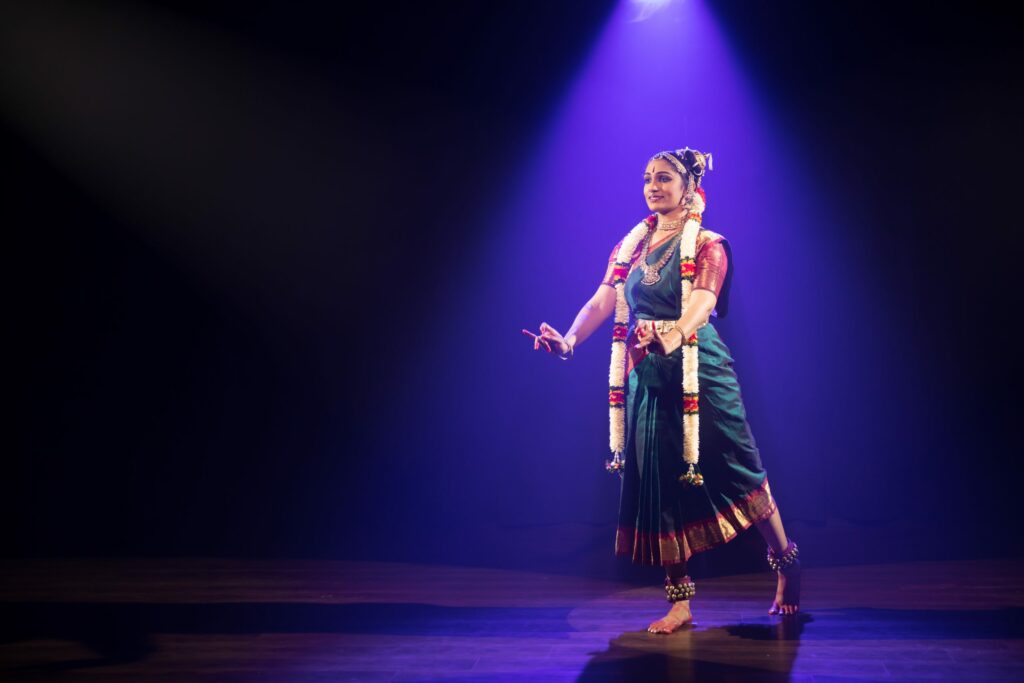
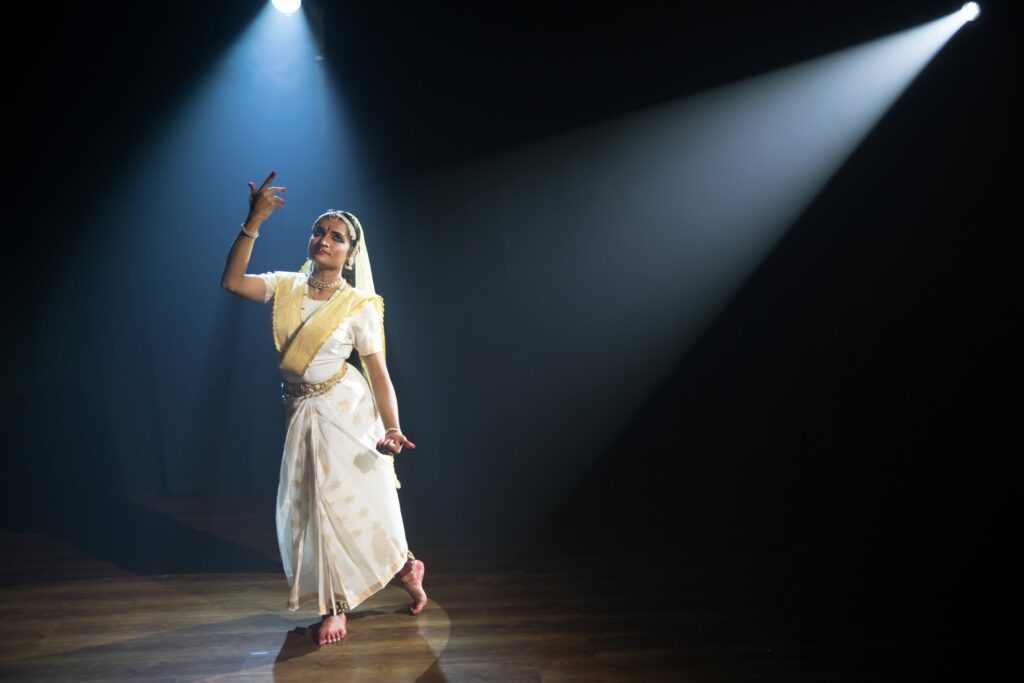
THIRUMAYILAI KURAVANJI
Review by Harish Chandhar
The Indian Performing Arts Convention (IPAC) presented a Digital Performance of the ‘Thirumayilai Kuravanji’ under the IPAC Australia 2021 series of lectures, workshops and dance intensives. The film screened was a recording of a pre-pandemic live performance presented by team ‘Parashah’ in collaboration with Natyarangam (the dance wing of Narada Gana Sabha, Chennai) in 2019. The dance production is based on a work of Yazhpanam Veeramani Iyer and the music was composed by senior musician Suguna Varadachari. The main intent of this article is to present my observations and impressions from watching the performance and attending the post screening discussion.
The ‘Thirumayilai Kuravanji’, as several other Kuravanji Natakam’s, has a standard storyline – A Nayika (here, Karpagambal) who falls in one-sided love with her Lord (here, Kapaleeswarar of Mylapore), a Thozhi (friend) in whom the Nayika confides her love, a Kurathi (fortune teller) who foretells the success of the Nayika’s love and puts an end to her anxiety. Many temples of the Tamil land each have a Kuravanji dedicated to their Lords with a similar theme. The happiness of watching and enjoying such an easily predictable story lies in the beauty of poetic Tamil, the vivid imagery of landscapes, detailed descriptions of situations, liveliness of characters and the subtle humour involved in each scene.
The literary work of ‘Thirumayilai Kuravanji’ is a marvel in itself. The use of simple language yet maintaining the poetic quality of Tamil, makes it easily accessible to the audience. Starting with a description about the temple procession of Mylapore, an Ammaanai song about a game played by Karpagambal with her friends, a song addressing the cool breeze, the moon and Manmatha (Cupid) who torment the heroine by reminding her of her lover, a Ninda-Stuti song sung by the heroine’s friend accusing the Lord for troubling the heroine, a song by the Kurathi describing her ancestry and the greatness of her country, a Mangalam song to celebrate the happy end as predicted by the fortune teller – each song is so detailed in imagery and so suitable for interpretation in dance. This work brings together several genres of traditional poetry that once existed in the Tamil land.
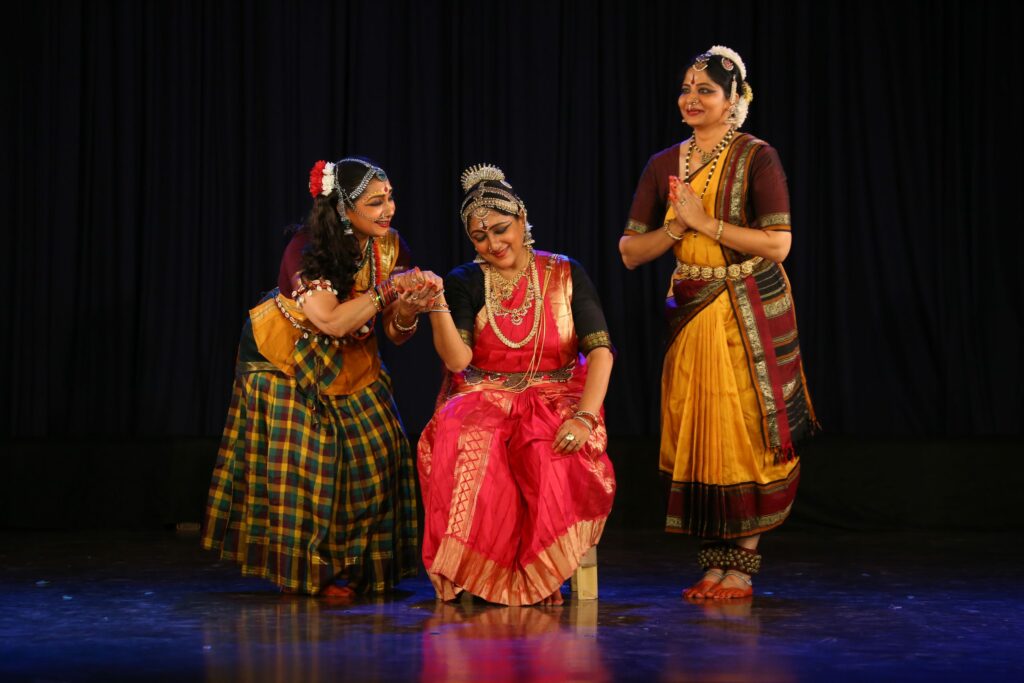
The music is a big support to the production. It was revealed in the post screening discussion that the composer Suguna Varadachari chose to tune the verses in the ragams as mentioned by the author Veeramani Iyer himself. Along with popular Kavadi and Kummi tunes, the music had other songs tuned in a simple yet classic manner which allowed emphasis on the clarity of Tamil lyrics. One needs to commend the commitment of the composer to honour the author’s visualisation of his own work.
The performance of the Kuravanji reflected the artists’ intent to stick to the traditional approach of the literary work, and yet add in their own innovative touches. Apart from a traditional approach to monologues and conversations between the characters, there were other additions like a well choreographed Alarippu performed by a group, the Nandi Chol accompanying the procession of Kapaleeswarar, the Pinnal Kolaattam as a celebratory end to the performance. Though not within the framework of Kuravanji natakams, these additions blended well into the performance and made it a contemporary take on a traditional piece of literature.
POST SCREENING DISCUSSION
The Kuravanji – a discovery!
Sujatha Vijayaraghavan, reminisced about how she became acquainted with the work ‘Thirumayilai Kuravanji’. In 1957, the well known author Kothamangalam Subbu had written a novel called ‘Thillana Mohanambal’ which used to be released as a weekly series in a popular magazine (It was this novel that was later adapted into a famous film of the same name starring Sivaji Ganesan and Padmini in lead roles). In the book, there is a scene where the heroine Mohanambal performs an item of the Kurathi genre in a wedding in Mylapore. A few verses of the Kurathi song “Mayilai Kuravanji Vandaal !” appear in the scene. Having watched the famous ‘Kutraala Kuravanji’ choreographed by Vazhuvoor Ramaiyya Pillai and performed by the legendary sisters Kumari Kamala and Rhadha, these Kurathi verses made a deep impression in a young Sujatha, who herself was a dance student. Years later in 2009, when requested to conceptualise a dance piece that could represent the cultural ethos of the Chennai city, she was reminded of these Kurathi verses and she set on to find out if this was part of a larger Kuravanji work. Through a friend Viswanathan (the son of Kothamangalam Subbu), she got to know that these verses were indeed taken from a full work called ‘Thirumayilai Kuravanji’ authored by the late Yazhpanam Inuvil Veeramani Iyer who was a Tamil scholar, writer and musician of Sri Lankan Tamil origin. It was Kothamangalam Subbu who persuaded Veeramani Iyer to pen a Kuravanji on the Lord of the Mylapore Kapaleeshwarar Temple. Veeramani’s book ‘Thirumayilai Kuravanji’ was released in the Kapali temple by Subbu on 24th March 1957 around the same time when the latter was writing the novel ‘Thillana Mohanambal’. Recharged with all this background information, a hopeful Sujatha tried to locate the book in libraries (including the temple library) and in friends’ collections, but none of her attempts proved successful. Finally through some Sri Lankan Tamil connections, she contacted the aged wife of the late author in Sri Lanka and sourced the complete version of the ‘Thirumayilai Kuravanji’. It is indeed fascinating that a fond childhood memory has enabled Sujatha to unearth a magnificent work decades later which was almost forgotten by the literary world.
THE PROCESS
Team ‘Parashah’ is an artiste group of four primary dancers – Roja Kannan, Priya Murle, Srikanth Natarajan, Aswathy Srikanth and their students. Formed in 2002, the team has been presenting group works and thematic productions for over fifteen years. Roja Kannan described how their team ‘Parashah’ was commissioned with this work. On the 15th anniversary celebrations of the team, Sujatha Vijayaraghavan (who was instrumental in bringing the four dancers together as a team in 2002 through Natyarangam), assigned them with their next project – the ‘Thirumayilai Kuravanji’. It was a pleasant surprise for the team that had already worked on another Kuravanji dedicated to Ardhanareeswarar of Thiruchengode. When the roles were lot-picked by the dancers to decide who would perform which role in this drama, interestingly each dancer ended up with the character they had performed in the previous Kuravanji! Thus Roja was to perform as the Kurathi, Priya the Rani (Nayika), Ashwathi the Thozhi (Rani’s confidante) and Srikanth the Kattiyakaran (narrator).
Having produced several works over fifteen years, the team has an efficient delegation of duties to each member of the group, who take independent responsibilities of the different aspects related to the production. While Roja takes care of administration, public relations and setting of the orchestra, Priya and Srikanth handle the group choreography with their students (though the individual portions of each dancer are choreographed by themselves). Priya added that the success of the group lies in their harmony of thought, lack of seniority clashes and willingness to learn from each other’s fields of expertise. Srikanth was credited for his expertise in the Tamil language and his artistic inputs influenced from the Bhagavata Mela theatrical tradition that he hails from. Priya stressed on the team’s intent to maintain the classicism of the Kuravanji and not portray the Kurathi as a casual gypsy woman. Roja recounted the advice that she received from her late Guru Adyar K Lakshmanan when the team performed the previous Kuravanji. He warned Roja against getting carried away by the liveliness of the character and to ensure that she maintains the ‘gauravam’ of the ‘Deiva Kurathi’. Keeping this advice in mind, though she did incorporate a few movements from the folk dance genre, their usage was minimal to not let down the classicism of the Kurathi. Talking about building the characterisation of her role, Priya pointed out that unlike the Rani’s of the other Kuravanji’s, the heroine of this work, Karpagambal, is quite an outspoken girl who cannot tolerate the Kurathi talking ill of her Lord. Yet Priya had to be mindful about balancing the heroine’s fiery attitude with the reserved gentle nature that is naturally expected of such divine female characters.
A HAPPY CONFLUENCE OF THE OPPOSITES…
Sujatha ended the discussion by beautifully describing some interesting aspects of Kuravanji literature. Kuravanji is historically the only dramatic form within the Bharatanatyam genre, which is otherwise primarily a solo tradition. It is a reflection of all aspects of dance including Aharya (costuming) and Vachika (song and dialogue). Though the Kuravanji is centred around the Nayaka (Hero/ Lord), he never makes an appearance in any of the scenes! The Kuravanji is also a union of the opposite worlds – a juxtaposition of the lives of a princess and a mountain girl, the urban and the rural, the literary language and the spoken dialect, highly classicised music and folksy tunes. A literary format that allows for the seamless coming together of stark differences is probably the reason for the popularity of the form. The very many Kuravanji Natakam’s written on ancient temples of Kutraalam, Viralimalai, Thiruvarur, Thiruchengode, Azhagarmalai and the ones written on Kings like the ‘Sarabhendra Bhoopala Kuravanji’ on King Serfoji the 2nd and the ‘Bethlehem Kuravanji’ written on Jesus Christ, stand testimony to the popular appeal of the literary format in the olden days.
My sincere gratitude to Indian Performing Arts Convention (IPAC) headed by Aravinth Kumarasamy of Singapore, for making this production available for us to watch and enjoy. Thanks to the panelists for generously sharing their experiences and insights about working on this production in the post-screening discussion. Such sessions would be very helpful for students and rasikas alike. Dance institutions should encourage their students to embrace such opportunities to observe a performance, engage in conversation with the artistes and gain insights on the process of coming together of such a high quality production.




